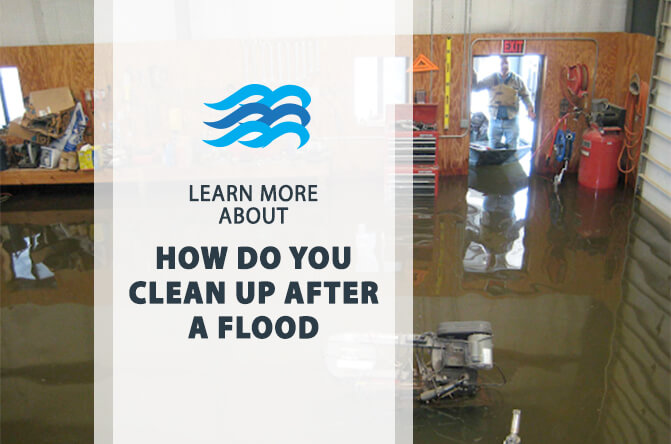
is to How Do You Clean Up After a Flood?
If you live in an area that is prone to flooding then you’re probably already prepared to deal with flood damage restoration. If not, then read on. Unfortunately, there’s no way to stop a ‘flood’ and the damage caused by such a natural calamity can be devastating. Moreover, it can be very hard to reverse if you take too long to react. This is why it is important to know how to clean up after a flood. Most importantly, not cleaning up after a flood can lead to your claim being denied.
Household water damage costs over $20 billion per year in the US. Water that has been left for too long can become a breeding ground for all sorts of bacteria as well as mold that can leave a putrid odor all around your house, result in illnesses, and also cause damage to the property. Additionally, not acting quickly can leave water stains all over the walls of your house that can be hard to get rid of.
Once you’ve survived the initial chaos of a storm or flooding, it is important to act quickly.
Here’s how to clean up after a flood:
When dealing with flood damage restoration Salvage What You Can
Survey your property and see what you can save. When separating everything, ask yourself this question: can I disinfect or wash this item? If the answer is no, then you will probably have to destroy it.
Things that usually cannot be kept after being affected by flood water include bedsheets, pillows/pillowcases, food items, and cosmetics.
On the other hand, utensils such as cookware and glassware are easy to salvage. Pick such things and keep them in a safe and dry place. However, make sure to wait for things to settle before you start this job. Your safety should always be your first priority. Do not enter the house if there is a risk of drowning, injuries, electrocution, etc.
During flood damage restoration Start By Removing Water From Your Property
It is important to remove water as quickly as you can. In most cases, you will not be able to do it manually and will need the help of a machine.
Here are some of the tools you can use for effective water removal:
- Flood Pump – Flood pumps can help remove standing water out of your home in a short amount of time. A good flood pump can extract about 50 gallons of water every minute. Starting from the very last room in your house and slowly extract every drop of water.
- Shop Vacs – Shop Vacs are also good for removing water from around the house, specifically rugs and carpets. These are vacuums built specifically to suck up water. It will be hard to salvage your carpets and rugs without this tool.
- Desiccants like Clay or Silica Gel – Desiccants can absorb water up to a certain limit and may not be suitable in all conditions. On the plus side, they are affordable and easy to use. Put the bag where there’s water and the bag will change color as an indicator when it is time to switch the bag.
Again, remove water only when you are sure it is safe to enter the house. Wait for things to settle down if it seems too risky to start removing water now.
Sanitize surfaces
Once you’ve gotten rid of the water around the house, it is important to sanitize all surfaces. This will help reduce the risk of mold. You will, however, have to be very careful if there are already signs of mold in the house as it could result in health issues.
Here’s how to create a mix to clean surfaces: create a mixture of 5 gallons of water and one cup of bleach. Use a mop to spread this mixture along the floors of your home (after you get rid of the carpet).
Let this mixture air dry or use a fan to help dry the sanitizing mixture from the floor. You will need to create a stronger concoction (use warm water and one cup of bleach for every one gallon of water) if there already are signs of mold.
Set Up A Dehumidifier
Mold accumulates in moist areas where there is little to no airflow. Dehumidifiers can reduce the risk of mold and make your home safer. Hence, install them wherever you can.
They absorb moisture from the air and prevent the growth of stubborn mold.
Indeed, flood damage restoration can lead to waste infiltration due to drain backup: Get Rid of the Waste
Gather up wet wallpapers, moldy insulation layers, and debris of all kinds, and toss it all away. However, make sure to use garbage bags for this purpose. Also, take plenty of pictures for insurance purposes, though.
This is all you need to know about flood water removal. Cleaning up flood water can be risky if you have no professional help, so make sure to look for a company that offers flood water removal. Get Delmar has been in the business for years and has the tools and manpower needed to quickly suck out every drop of water in your property and make it livable again. Get in touch with us to discuss more.